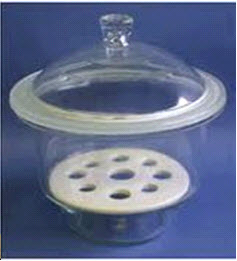Site pages
Current course
Participants
General
Module 1. Moisture content and its determination.
Module 2. EMC
Module 3. Drying Theory and Mechanism of drying
Module 4. Air pressure within the grain bed, Shred...
Module 6. Study of different types of dryers- perf...
Module 5. Different methods of drying including pu...
Module 7. Study of drying and dehydration of agric...
Module 8. Types and causes of spoilage in storage.
Module 9. Storage of perishable products, function...
Module 10. Calculation of refrigeration load.
Lesson-4_1:Methods of EMC Determination
However, in storage the moisture content controlled by circulation of air and control of the relative humidity. Hall (1980) mentioned two different methods for determining the EMC:
1. Static method, in which atmosphere surrounding the product comes to equilibrium with the product without mechanical agitation of air or product.

2. The dynamic method, in which the atmosphere surrounding the product itself is mechanically moved.
He preferred the static method than the dynamic one. Although, the dynamic method is quicker but represents problems in design and instrumentations. Therefore, the static method has been used extensively. Several weeks may be required using static method, whereas, with dynamic method the data may be obtained in couple of days or less. He also stated that when using static method for determining the EMC, saturated salt solutions or acids may be used for maintaining the desired relative humidity at the temperature of storage.
1. Steps for equilibrium moisture content determination
For the determination of EMC curves, the following basic steps are necessary regardless of the method used:
1. Sample collection
2. Exposure of the samples to different relative humidities (Rh) at a given temperature T (until equilibrium is reached, respectively)
3. Determination of moisture content
2. Principle of the dynamic method
-
Equilibrium moisture content is an important moisture characteristic of porous materials, but its determination has required considerable time and care and the judgement of equilibrium may eventually be arbitrary.
-
Dynamic method that can predict the equilibrium moisture content by curve-fitting to sorption kinetics experiments was proposed in the absence of accuracy consideration.
-
In the equation of continuity of water in porous media, water diffusivity is normally a function of the moisture content.
-
Relationship between the concentration of a mass in a porous material isothermally in equilibrium with that in the environment is called sorption isotherm.
-
When the mass is water, the relation between atmospheric relative humidity and equilibrium moisture content of materials is the water vapor sorption isotherm, which is an indispensable material property when studying moisture behavior of porous hydrophilic materials such as cement-based materials.
-
Especially in moisture transport analysis, moisture capacity that can convert the chemical potential gradient or relative humidity gradient into moisture content gradient, can be obtained from the water vapor sorption isotherm.
-
As the name implies, it takes so long time to obtain "equilibrium" values that difficulties of changes in material properties may arise.
3. Conventional methods
Correct equilibrium moisture content can be obtained when a relative humidity is accurately generated and the adsorbed mass is continuously weighed.
Standard methods of relative humidity generation include the saturated salt solution method, flow-division method that mixes dry and saturated air and the method altering temperature or pressure or both. The volumetric method that isothermally changes the vapor pressure in a vacuum system has been widely used in the chemical engineering laboratory.
-
The saturated salt solution method can produce a relative humidity with a precision of 1 percent when the container of the salt solution is stirred and the temperature is controlled carefully.
-
Haggymassy combined weighing bottle with saturated salt solutions under vacuum and determined isotherms of hardened cement pastes. The mean free path of water vapor decreases under vacuum leading to an increase in its diffusivity in air. This reduces the time to reach equilibrium and is effective in preventing carbonation of cement based specimens. Yuasa and co-workers ground specimens into powder and introduced stirring mechanism in a saturated salt solution container. With all these means, the saturated salt solution method has an disadvantage of generating limited number of relative humidities. This method, as well as the volumetric method, is a standard with its simplicity, and is placed as the reference method of this study.
4. Principle of the dynamic method
- In the equation of continuity of water in porous media, water diffusivity Dq is normally a function of the moisture content q. In this experiment, the equation is taken as linear because an adsorption experiment will be executed under a constant relative humidity. For a sphere with a radius r, the water balance equation may be given by:
Which can be converted to the one dimensional linear equation by substituting q with u/r. The initial and the boundary conditions are that the surface moisture content of a sphere with a radius R, or relative humidity in equilibrium with the moisture content, is always constant and that the initial moisture content of the sphere in the beginning of adsorption is zero,
With variables separation method, the following formula is obtained
where m(t) is the total mass passed from the surface of a sphere in a finite time, me is the total mass passed after the infinitely long time and k is Dqπ2/R2.